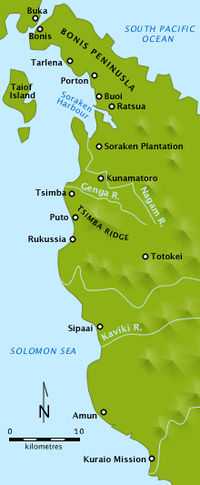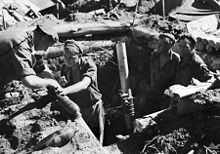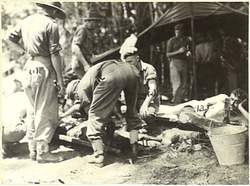Battle of Tsimba Ridge
| ||||||||||||||||||||||||||||||
The Battle of Tsimba Ridge was a battle of the Second World War involving Australian and Japanese forces. Part of the wider Bougainville Campaign of the Pacific theatre, the battle occurred in the northern sector of Bougainville Island between 17 January and 9 February 1945, when the lead battalion of the Australian 11th Brigade—the 31st/51st Battalion—advanced towards the Genga River as they drove towards the Bonis Peninsula. Coming up against heavy resistance along Tsimba Ridge, the Australian advance was halted for three weeks as they fought to wrest control of the ridge from the Japanese defenders. The main Australian attack came on 6 February, however, it was not until 9 February when the Japanese completely withdrew from the position. Nevertheless, fighting in the surrounding area continued until 22 February.
Background

In November–December 1944, the Australian II Corps under Lieutenant General Stanley Savige took over responsibility for Allied operations on Bougainville from the American XIV Corps. Mistakenly believing that the Japanese forces on the island numbered just 17,500 men[3] it was decided that the Australians would pursue an aggressive campaign to clear the Japanese from Bougainville.[4] The campaign developed into three separate drives: in the north, it was planned that Japanese forces would be forced into the narrow Bonis Peninsula and contained; in the centre the seizure of Pearl Ridge would give the Australians control of the east–west avenues of approach, as well as affording them protection against further counter-attacks, while also opening the way for a drive to the east coast; and the main campaign in the south, where the bulk of the Japanese forces were concentrated.[5] Allied estimates of Japanese strength were later found to be grossly inaccurate and after the war it was found that the number of Japanese alive on the island at this time was closer to 40,000.[6]
Prelude
On 31 December Savige ordered Brigadier John Stevenson, commander of the 11th Brigade to begin clearing operations along the northeast coast of the island towards Soraken Harbour,[7] as they attempted to drive the Japanese in the sector on to the narrow Bonis Peninsula. At the time the Australians believed there to be around 390 Japanese defending the area surrounding the Genga River—considered to be the main Japanese defence line in the northern sector—however, it was later determined to be closer to 900 men from the 81st Infantry Regiment, under the command of Lieutenant Colonel Shinzo Nakamura.[2] Nakamura, who according to Peter Charlton was considered to be a "master of jungle warfare",[8] had been ordered to prevent the Australian advance along the coast, but had perceived the likelihood of stopping them before the Genga as being unlikely and had as such decided that he would concentrate his defence around Tsimba Ridge, with supporting elements being placed to the north, near Kunamatoro.[8]
Taking over control of the northern sector from the 7th Brigade, which was subsequently transferred to the southern sector to take part in the main offensive,[9] the 11th Brigade advanced along the coast from Kuraio Mission, sending out patrols into the interior to flush the Japanese out of their positions in the mountains as they went.[7] The 31st/51st Battalion, under the command of Lieutenant Colonel Joseph Kelly[10][Note 2] and roughly 800-strong, formed the vanguard of the advance, its main body moving along the coast road towards Amun, Sipaai and Rukussia, while patrols were sent inland from Totokei towards Lalum and Soraken, both of which were considered key Japanese positions. By 16 January the lead company of the 31st/51st reached Rukussia, having encountered no Japanese up until that point.[7][12]
Battle

The first contact came on 17 January when the 31st/51st Battalion's advanced elements—drawn mainly from 'D' Company—moved north from Rukussia and proceeded towards the Genga River.[12] Reaching a clearing 1,000 yards (910 m) north of Puto, a platoon-sized patrol came across a number of huts in a cleared area and proceeded to launch an attack on it.[13] One Japanese was killed in the initial attack, however, as the Australians took the huts and pushed forward beyond them, they were engaged from entrenchments 100 yards (91 m) in front of them. The Japanese then proceeded to launch a counter-attack using light and heavy machine guns. In response, the Australians brought up another platoon and over the course of two days the counter-attack was repulsed, with six to eight Japanese estimated to have been killed and a number wounded, while two Australians were wounded.[7][13]
During the engagement the Japanese had opened up with the artillery that they had brought up in support of the main defensive position on Tsimba Ridge,[Note 3] firing for the first time in the sector; this barrage, however, proved largely ineffective, inflicting only one casualty,[13] as many of the shells proved to be faulty and did not detonate.[7] The Australians also came across large camp, including a field hospital, which they captured intact, while another group of huts was discovered, from where they gained intelligence identifying the Japanese troops in the area as belonging to the 81st Infantry Regiment. They also managed to capture two 70 mm guns, and a quantity of ammunition for them.[13][15]
On 19 January the 31st/51st Battalion's 'A' Company sent a patrol out to outflank the Japanese forward positions; this patrol moved first to the right flank and then headed north along the tracks around Totokei and Goton. Discovering evidence of Japanese movement in the area, they followed these to the village of Kunamatoro, about 1 mile (1.6 km) north of Junapopo.[13] Here they encountered a force of around 30 to 50 Japanese and after the initial contact, in which the Australian platoon commander was wounded, the patrol attacked the village. Within 10 minutes the battle was over: 14 Japanese had been killed, along with a further five wounded, while the Australians suffered one killed, one wounded and one missing. As darkness fell, the Australian patrol withdrew from the village.[7]
The following day—20 January—the advanced elements of the Australian force pressed on towards Tsimba Ridge.[16] A formation about 200 yards (180 m) long and about 60 feet (18 m) in height, and stretching westerly to the Genga River where a steep cliff fell to the southern bank of the river, the ridge blocked the Australian advance across the river, while its south-eastern most protrusion (later known to the Australians as the "Pimple") was separated by a shallow saddle. On top of the ridge, dense jungle provided good concealment, while the approaches to the ridge were largely open to observation.[17] As the Australians approached the ridge, one of their platoons captured a 47 mm gun which had been positioned along the coast about 1,000 yards (910 m) south of the ridge, while another platoon contacted a lone Japanese soldier, who was killed in the subsequent fire fight as they entered a garden that curved along the southern approach to the ridge, and which became known as the "Amphitheatre".[16] After the initial contact, the platoon's advance through the garden was prevented by an intense burst of fire from the ridge, however, the Australians proceeded to scale the high ground that rose to their east and subsequently they were able to occupy the south-eastern tip of the Pimple, capturing two 75 mm guns in the process.[16]
Reports had been received from locals that the Japanese had brought reinforcements down from Soraken, Taiof Island and Tarlena,[16] and at this point the Australians realised that the Japanese had concentrated in far greater numbers than anticipated and had in fact established their line of resistance in the sector upon the ridge.[7] This was confirmed later after the Australians moved forward once more on 21 January, moving to within 800 yards (730 m) from the Genga River, where the track upon which they were advancing opened into a large garden, which curved around the edge of Tsimba Ridge, from where the Japanese defenders had an excellent line of sight.[15] Subsequent patrols determined the extent of the Japanese position, reporting that they had constructed a well-fortified position with a continuous trench along the crest of ridge, weapons pits and pill boxes, all with clear fields of fire, stretching up to 150 yards (140 m).[15]
The Australian commander, Kelly, ordered 'B' Company to move up and take the ridge and over the course of a week between 21–28 January they made a number of attempts. These proved fruitless, however, although one platoon managed to encircle the position from the north before being engaged with heavy machine gun fire. On 23 January, the Australians established fire support in the form of guns from the 2nd Mountain Battery. Another three unsuccessful attempts were made on 24 January, while on 25 January 'C' Company carried out a movement to the flank in an attempt to get around behind the ridge and attack from the north. Crossing the crocodile-infested waters of the Genga about 600 yards (550 m) from the ridge, the Australians established a bridgehead across the river with a line of communications back to the Pimple, which they kept open by maintaining a constant patrol along it.[18]

Over the following six days, the Japanese proceeded to attack the bridgehead,[19] launching a number of attacks that bordered upon suicidal.[18] These attacks were repulsed and the Australians began to launch patrols in all directions around the ridge. On 29 January the Japanese launched a large scale attack on 'C' Company's positions and although the Australians resisted stubbornly, the attack succeeded in breaking through one part of the perimeter and managed to roll up the position all the way to the main battalion position around Puto before it was turned back. The Australian counter-attack, organised by the 'C' Company's commander, Captain Alwyn Shilton, and supported by accurate artillery fire, came on 1 February and resulted in over 30 Japanese killed or wounded.[19]
For the next few days further probes were made by the Japanese, which were also repulsed and the Australians consolidated their positions in preparation for an assault on the ridge. Preparations at this time included the manhandling of a mountain gun from Puto to a position 150 yards (140 m) from the Pimple, from where it could fire directly upon the Japanese positions on the ridge, while aircraft from No. 5 Squadron, Royal Australian Air Force carried out reconnaissance. In order to maintain the secrecy of these preparations, mortar fire was brought down upon the Japanese positions to mask the sounds of digging and movement while machine gun fire from Vickers machine guns kept the Japanese defenders from being able to leave their shelter and observe.[20]
The attack finally came on 6 February. Supported by a barrage of over 500 artillery shells and mortar bombs, three platoons from 'B' Company assaulted the ridge from different points in an effort to encircle the defenders. Following the artillery preparation fire, the attack began at 0900 hours when two platoons—10 and 11 Platoons—along with company headquarters formed up south-east of the amphitheatre and began to advance to the north-west 200 yards (180 m) to attack the ridge from behind, while another force—12 Platoon—attacked from the garden, moving around the Pimple before assaulting the ridge from east.[21]
From the north-west, 10 Platoon, in the centre, managed to capture its objectives by 09:25 hours; however, 12 Platoon came under intense fire and after suffering several casualties stopped their advance. By 11:30 hours the northernmost Australian platoon, 11 Platoon, had reached the high ground on the north-western side of the ridge, completing the encirclement of the Japanese, but the defenders refused to give up the position.[21] The attack cost the Australians nine killed and 20 wounded.[22] The next day the Japanese launched a counter-attack which, although repulsed, enabled them to continue to maintain a small pocket of resistance on the western tip of the ridge; this was finally abandoned on 9 February when an airstrike was called in upon the position and the Japanese withdrew from the feature.[23]
Aftermath
The Australians estimated that 66 Japanese had been killed defending the ridge and also captured a large amount of equipment, including four field and six anti-tank guns, nine machine guns and 86 rifles.[23] Australian casualties were approximately 23 killed and 53 wounded.[Note 4] From documents captured after the war, the Japanese believed that these losses would slow the Australian advance down. At the time they did not perceive the loss of Tsimba Ridge to be a defeat. They had been prepared to hold the position, and had the numbers to do it, however, Nakamura had decided to withdraw from the ridge when the morale of his troops had fallen due to lack of ammunition and food and rising casualties from tropical diseases.[24]
After the fall of Tsimba Ridge, fighting continued around the Genga River for the next couple of weeks. On 10 February the area south of the Genga had been cleared of Japanese and the Australians began to patrol along the northern bank. A number of minor clashes occurred, the most serious of which saw three Japanese killed and three Australians wounded in an action in which the Australians managed to capture a Japanese 37 mm gun.[23] As the Japanese were forced to withdraw from a position along the track which ran 150 yards (140 m) from the river, the Japanese artillery intensified and a number of men from the 31st/51st Battalion became casualties.[25]
The 31st/51st Battalion continued operations around the Genga River until 22 February, when they were relieved by the 26th Battalion, who continued the advance north towards Ratsua.[26] In total, the Australians lost 34 killed and 91 wounded in the fighting around the Genga River, while it was estimated that the Japanese lost 148 killed.[2] For their involvement in taking Tsimba Ridge, the 31st/51st Battalion were awarded the battle honour "Tsimba Ridge".[27]
Notes
- Footnotes
- ↑ The main fighting around Tsimba Ridge took place between 17 January and 9 February, however, fighting in the area around the ridge along the Genga River continued until 22 February.[2]
- ↑ Kelly later went on to command the 1st Battalion, Royal Australian Regiment after the war.[11]
- ↑ The Japanese name for Tsimba Ridge was Sun Highland.[14]
- ↑ Australian casualties to 1 February were 14 killed, 33 wounded. A further nine killed and 20 wounded were suffered during the main attack on 6 February.[21]
- Citations
- ↑ "Tsimba Ridge". Australian War Memorial. Retrieved 13 December 2009.
- ↑ 2.0 2.1 2.2 Long (1963), p. 126.
- ↑ Long (1963), p. 102.
- ↑ Johnston (2007), p. 30.
- ↑ Johnston (2007), pp. 30–31.
- ↑ Grey (2008), p. 191.
- ↑ 7.0 7.1 7.2 7.3 7.4 7.5 7.6 Long (1963), p. 122.
- ↑ 8.0 8.1 Charlton (1983), p. 52.
- ↑ Maitland (1999), pp. 108–109.
- ↑ Burla (2005), p. 146.
- ↑ "Joseph Lawrence Andrew Kelly, DSO". Australian War Memorial. Retrieved 6 December 2009.
- ↑ 12.0 12.1 "31st/51st Battalion (Kennedy and Far North Queensland Regiment)". Second World War units, 1939–1945. Australian War Memorial. Retrieved 4 April 2009.
- ↑ 13.0 13.1 13.2 13.3 13.4 Burla (2005), p. 152.
- ↑ Tanaka (1980), p. 295.
- ↑ 15.0 15.1 15.2 Long (1963), p. 123.
- ↑ 16.0 16.1 16.2 16.3 Burla (2005), p. 153.
- ↑ Burla (2005), pp. 153–154.
- ↑ 18.0 18.1 Burla (2005), p. 154.
- ↑ 19.0 19.1 Long (1963), p. 124.
- ↑ Burla (2005), pp. 155–156.
- ↑ 21.0 21.1 21.2 Burla (2005), p. 156.
- ↑ Long (1963), pp. 124–125.
- ↑ 23.0 23.1 23.2 Long (1963), p. 125.
- ↑ Charlton (1983), pp. 51–52.
- ↑ Burla (2005), p. 157.
- ↑ Tanaka (1980), p. 297.
- ↑ Maitland (1999), p. 145.
References
- Burla, Robert (2005). Crossed Boomerangs: The History of All the 31 Battalions. Loftus, New South Wales: Australian Military Publications. ISBN 978-1-876439-67-5.
- Charlton, Peter (1983). The Unnecessary War: Island Campaigns of the South-West Pacific 1944–45. South Melbourne, Victoria: The MacMillan Company of Australia. ISBN 0-333-35628-4.
- Grey, Jeffrey (2008). A Military History of Australia (3rd ed.). Melbourne, Victoria: Cambridge University Press. ISBN 978-0-521-69791-0.
- Johnston, Mark (2007). The Australian Army in World War II. Botley, Oxford: Osprey Publishing. ISBN 978-1-84603-123-6.
- Long, Gavin (1963). The Final Campaigns. Australia in the War of 1939–1945, Series 1—Army. Volume VII (1st ed.). Canberra, Australian Capital Territory: Australian War Memorial. OCLC 1297619.
- Maitland, Gordon (1999). The Second World War and its Australian Army Battle Honours. East Roseville, New South Wales: Kangaroo Press. ISBN 0-86417-975-8.
- Tanaka, Kengoro (1980). Operations of the Imperial Japanese Armed Forces in the Papua New Guinea Theater During World War II. Tokyo: Japan Papua New Guinea Goodwill Society. OCLC 9206229.
Coordinates: 5°38′33.48″S 154°44′47.58″E / 5.6426333°S 154.7465500°E
